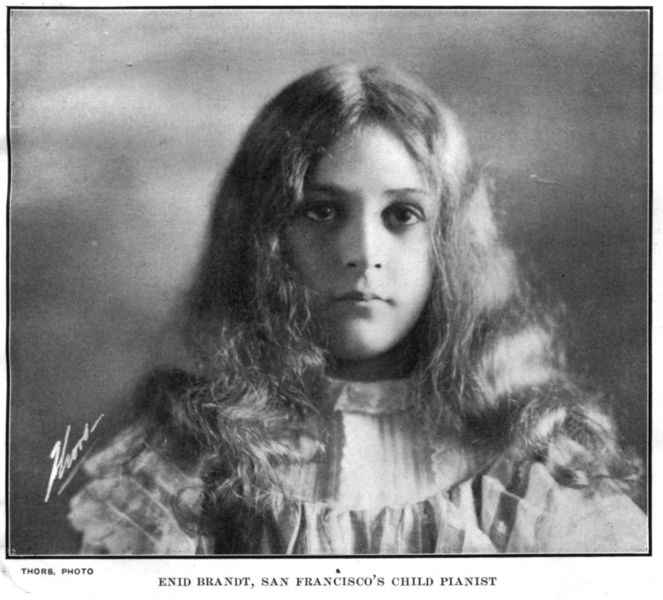
Enid Brant, Scrapbooked


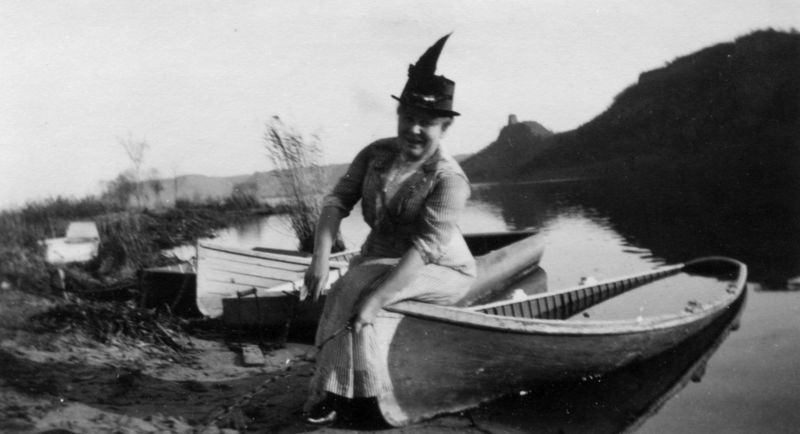
Don’t look now, Helene, but your fishing excursion isn’t going to get very far. Helene sent a copy of this photo to Marie (along with several others), probably because Marie was along on this girls-day-out. It’s sure good she’s near shore, though; unswamping a canoe in a long dress and snazzy hat would be quite difficult. Helene doesn’t appear too nonplussed — she’s got a few other canoes behind her to pick from.
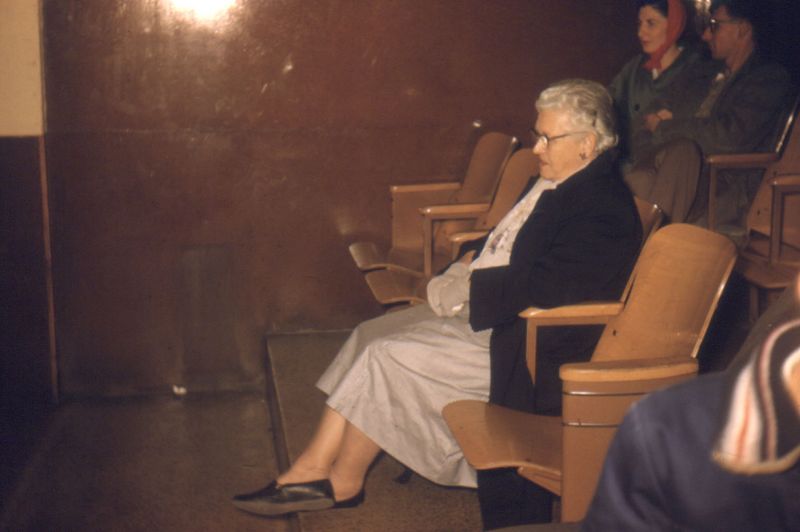 Whistler’s Mother (otherwise known as Arrangement in Gray and Black No. 1) is an iconic image in our culture, recalling a Victorian silence and respectability. Mrs. Melby’s Mother, above, spent Halloween 1960 at a bowling alley. My, how times change is a little less than a century! Not quite as much as you may think, though — the style of dress is similarly modest, although Mrs. Melby has gone stocking-free and is showing a little ankle. Her chair is similarly spartan, although anyone who attended a high school built earlier than 1960 is probably intimately familiar with such folding seats; many a small finger has been bit by those steel hinges while screwing around during an oh-so-important school assembly in the auditorium.
Whistler’s Mother (otherwise known as Arrangement in Gray and Black No. 1) is an iconic image in our culture, recalling a Victorian silence and respectability. Mrs. Melby’s Mother, above, spent Halloween 1960 at a bowling alley. My, how times change is a little less than a century! Not quite as much as you may think, though — the style of dress is similarly modest, although Mrs. Melby has gone stocking-free and is showing a little ankle. Her chair is similarly spartan, although anyone who attended a high school built earlier than 1960 is probably intimately familiar with such folding seats; many a small finger has been bit by those steel hinges while screwing around during an oh-so-important school assembly in the auditorium.
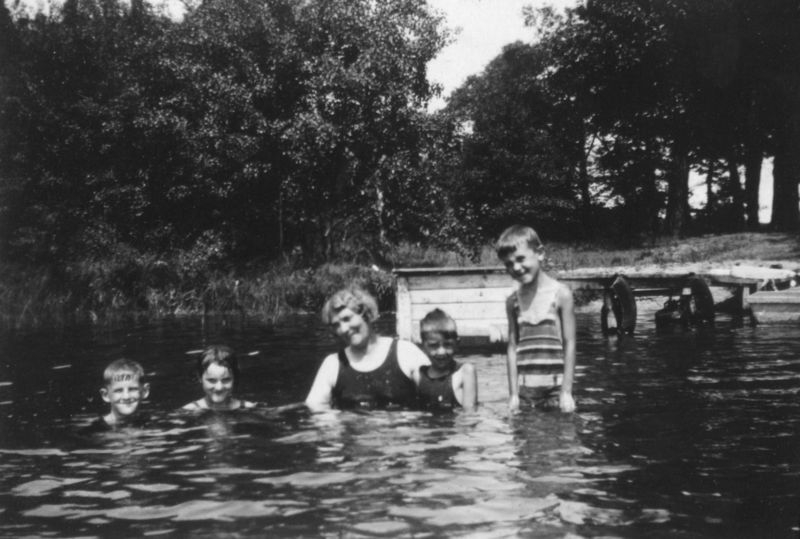
This photo is captioned “At Mt. Tello“. The rest of the series are from Wisconsin, so I assumed there must be a Mount Tello somewhere in the area. Google, sadly, has no results, but it sounds so familiar…Mt. Tello…Tello Mountain…Mount Tello — and a light turns on above my head. Along Highway 23 in central Wisconsin is a small town on a lake/river: Montello. Ruth must have asked, ‘where was this taken?’ and misunderstood the answer.
also: origin of Montello’s name * Montello Lake * downtown Montello * the falls in Montello
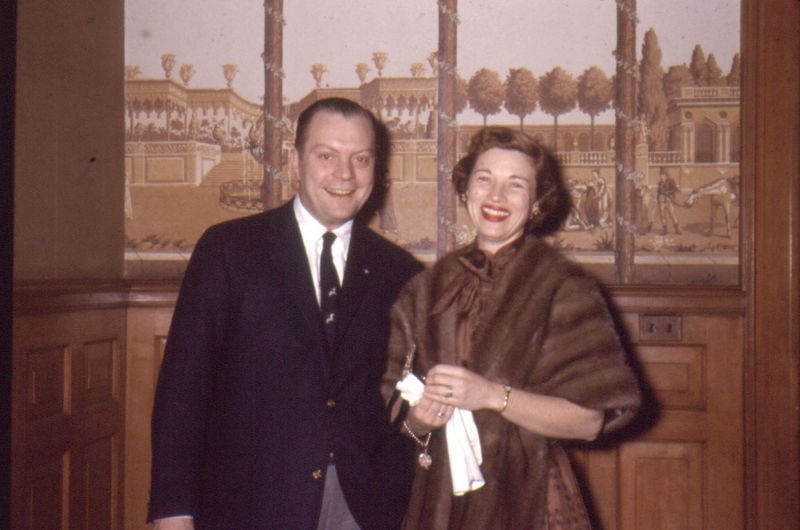 Say ‘hi’ to Larry & Ruth Smith, frequenters of the Pfister Hotel. This was taken in February 1957, along with several other photos I’ve uploaded. This photo has the best view of the trompe l’oeil wallpaper in the Pfister. A different wallpaper is visible in other photos, but this the best view of any of them. And it is wallpaper – you can see the seam just over the lady’s right shoulder, and note how the wall in the distance doesn’t line up between. The wallpaper artist used the ivy-wrapped columns to both hide the seam and create a ‘break’ to obscure varying views put side-by-side; my guess is that this paper (probably spendy) was sold with numerous vignettes, intended to be randomly juxtaposed for a more natural look. It was designed to be applied with a wainscoting, to leave the view appropriately at eye-level, and was probably quite expensive at the time. The Pfister was a classy place, though — it was worth it.
Say ‘hi’ to Larry & Ruth Smith, frequenters of the Pfister Hotel. This was taken in February 1957, along with several other photos I’ve uploaded. This photo has the best view of the trompe l’oeil wallpaper in the Pfister. A different wallpaper is visible in other photos, but this the best view of any of them. And it is wallpaper – you can see the seam just over the lady’s right shoulder, and note how the wall in the distance doesn’t line up between. The wallpaper artist used the ivy-wrapped columns to both hide the seam and create a ‘break’ to obscure varying views put side-by-side; my guess is that this paper (probably spendy) was sold with numerous vignettes, intended to be randomly juxtaposed for a more natural look. It was designed to be applied with a wainscoting, to leave the view appropriately at eye-level, and was probably quite expensive at the time. The Pfister was a classy place, though — it was worth it.
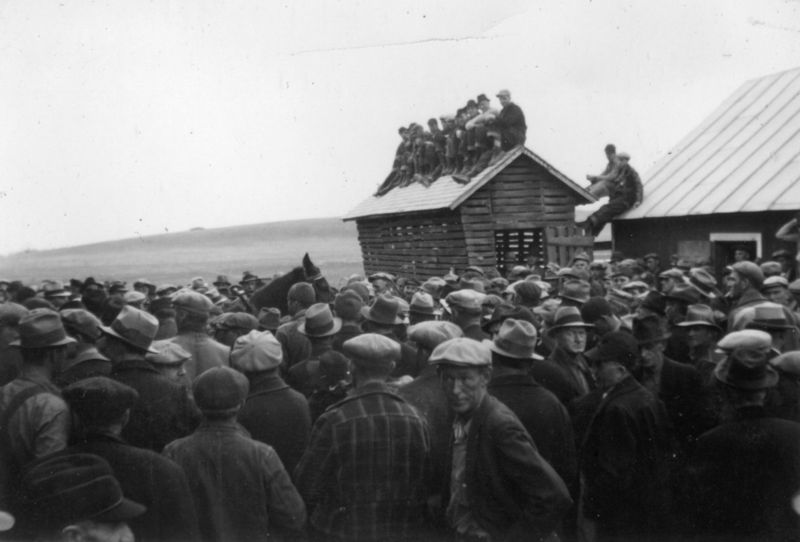 This image, one of two captioned “At Uncle Nick’s Auction,” shows a common sight around the rural USA during the 1930s. No, not just a crowd of fedoras and paperboy hats (although those were quite common, especially at the employment office or the bread lines). Farm foreclosures were driven by the Great Depression, a sluggish economy, a prewar slump due to foreign instability, and the ongoing change from a raw-materials economy to a manufacturing economy. This one appears to have been taken in 1938, after the “heyday” of foreclosures in the early 1930s. Early on, farmers protested and caused ‘penny auctions’ — friends and neighbors ran off genuine bidders, and never bid more than a penny for any lot. By the late 1930s the worst of it was over, some economic reforms were starting to help, and this auction was probably handled better than frantic bank-recoveries earlier in the decade.
This image, one of two captioned “At Uncle Nick’s Auction,” shows a common sight around the rural USA during the 1930s. No, not just a crowd of fedoras and paperboy hats (although those were quite common, especially at the employment office or the bread lines). Farm foreclosures were driven by the Great Depression, a sluggish economy, a prewar slump due to foreign instability, and the ongoing change from a raw-materials economy to a manufacturing economy. This one appears to have been taken in 1938, after the “heyday” of foreclosures in the early 1930s. Early on, farmers protested and caused ‘penny auctions’ — friends and neighbors ran off genuine bidders, and never bid more than a penny for any lot. By the late 1930s the worst of it was over, some economic reforms were starting to help, and this auction was probably handled better than frantic bank-recoveries earlier in the decade.
Also: farmer’s diary * iowa depression * nebraska foreclosures * remembering farm life
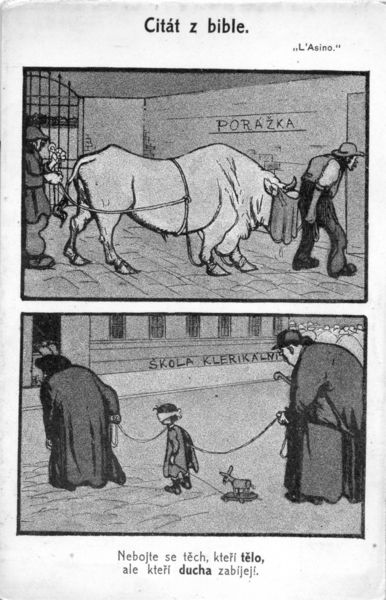 Last week’s postcard got a lot of attention thanks to SPS (nsfw), so here’s card #2. This appears to hail from the same time-period, but isn’t postmarked or dated like the previous card. The top line says, “Quotation From Scripture“, and the bottom reads, “So fear those who slaughter the body and the soul.” Like a bull to slaughterhouse (porážka), a child is taken in for religious education (škola klerikálni). The blindfold on the bull is used to keep it calm when leading it to slaughter; the child is also being taken ‘blindfold to the abattoir,’ oblivious to the harm approaching. Even without understanding Czech, the image is powerful without the direct accusation of destroying body and soul.
Last week’s postcard got a lot of attention thanks to SPS (nsfw), so here’s card #2. This appears to hail from the same time-period, but isn’t postmarked or dated like the previous card. The top line says, “Quotation From Scripture“, and the bottom reads, “So fear those who slaughter the body and the soul.” Like a bull to slaughterhouse (porážka), a child is taken in for religious education (škola klerikálni). The blindfold on the bull is used to keep it calm when leading it to slaughter; the child is also being taken ‘blindfold to the abattoir,’ oblivious to the harm approaching. Even without understanding Czech, the image is powerful without the direct accusation of destroying body and soul.
The quote isn’t right, though; I compared to several Czech translations available online, and the quote is similar to Matthew 10:28, which says not to fear enemies who can destroy the body, instead fear what God can do to your soul in Hell. By changing word-placement, the maker of this card accuses the clergy of making a Hell on earth for students left in their care.
I’ve read up a bit more on what group would be so critical of the church to produce these editorial cartoons so publicly. At the time, turn-of-the-20th-century, the Freethinkers were a prominent group in Czech life, growing from Bohemia and anti-Hapsburg sentiment. The Czech regions, ruled by Austria, were made Catholic states, and popular sentiment began to turn anti-church by the mid-19th century. The Hapsburgs rule ended, and the regions gained more autonomy through the end of the 19th century. Marxism and socialism were developing as social, non-governmental movements, the Freethought movement was very popular amongst the religion-suspicious populous. These postcards were popular-sentiment status quo for the young independent, Bohemian Czech Republic.
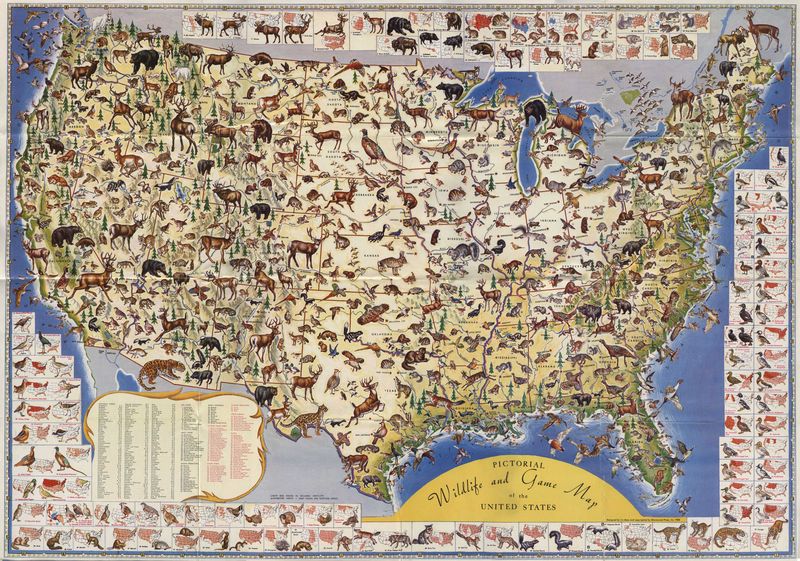 This is a “Pictorial Wildlife and Game Map” from 1956. Unlike a population map or ‘Game of the States”, this documents those critters we hate to have around, but really don’t want to disappear. In terms of information use, the map is very cluttered, but it does an pretty job of covering migration ranges and general locations. The central map shows the general locations of a variety of animals’ habitats, and around the edge we see species-specific ranges outlined in red. The hundreds of tiny animal drawings are excellent — I did my best to make it as large as possible to get more detail for you, but hitting my webserver’s limit of memory kept is smaller than I’d have liked. Still, the big version should give you a pretty good idea of who’s living where. [more maps]
This is a “Pictorial Wildlife and Game Map” from 1956. Unlike a population map or ‘Game of the States”, this documents those critters we hate to have around, but really don’t want to disappear. In terms of information use, the map is very cluttered, but it does an pretty job of covering migration ranges and general locations. The central map shows the general locations of a variety of animals’ habitats, and around the edge we see species-specific ranges outlined in red. The hundreds of tiny animal drawings are excellent — I did my best to make it as large as possible to get more detail for you, but hitting my webserver’s limit of memory kept is smaller than I’d have liked. Still, the big version should give you a pretty good idea of who’s living where. [more maps]
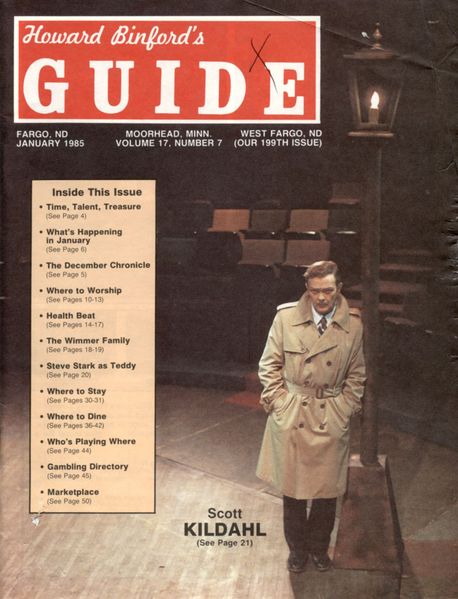 Howard Binford was a journalism instructor at Moorhead State University when he started his magazine: Howard Binford’s Guide, a free publication for tourists or other non-locals providing handy lists of places to eat and sleep, who’s performing in town, and other things of interest in the Fargo-Moorhead area. The magazine ran from 1968 until Binford died in 1989, with some changes throughout (as you’d expect in over 20 years of publishing), but the magazine kept its content and tone through the years. The magazine was sold to Kaye’s printing in 1986, and after Binford’s passing Kaye’s continued publishing as “Fargo-Moorhead Magazine” — after which they, themselves, were bought by the Fargo Forum. The magazine started in ’68 by a teacher continues today through the largest regional publisher in the Red River Valley.
Howard Binford was a journalism instructor at Moorhead State University when he started his magazine: Howard Binford’s Guide, a free publication for tourists or other non-locals providing handy lists of places to eat and sleep, who’s performing in town, and other things of interest in the Fargo-Moorhead area. The magazine ran from 1968 until Binford died in 1989, with some changes throughout (as you’d expect in over 20 years of publishing), but the magazine kept its content and tone through the years. The magazine was sold to Kaye’s printing in 1986, and after Binford’s passing Kaye’s continued publishing as “Fargo-Moorhead Magazine” — after which they, themselves, were bought by the Fargo Forum. The magazine started in ’68 by a teacher continues today through the largest regional publisher in the Red River Valley.
Each Guide had a profile or interview with some local dignitary; hardly a whos-who of international fame, Binford wrote about an interesting group of local religious leaders, businessmen, regional government, and amateur performers.
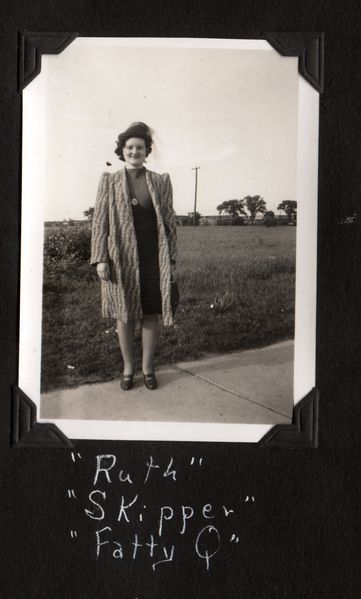 Here, to the right, is Ruth. She once had a photo album of her life in the late 1930s, which I’ve started scanning recently. On the second page of the album, she has a series of captioned photos captioned as a dramatis personae, identifying the players in her life. Her self-portrait includes several nicknames — “Fatty Q” being one of them. While not the lithest of ingenues, Ruth isn’t obese, so that might be why she’s accepted the nickname without offense. The nickname of ‘Skipper’ is interesting, too. The two things we associate ‘skipper’ with — the fat guy on Gilligan’s Island, and Barbie’s sister — were decades away from Ruth’s life. Captaining a boat was the main definition, although ‘one who skips’ could mean she either has a slight jump in her step, or maybe she prefers to avoid going to class. Either way, Ruth has two 1930s nicknames that she was proud enough to own to save it for her kids to see: I hope she was still as proud of them years later.
Here, to the right, is Ruth. She once had a photo album of her life in the late 1930s, which I’ve started scanning recently. On the second page of the album, she has a series of captioned photos captioned as a dramatis personae, identifying the players in her life. Her self-portrait includes several nicknames — “Fatty Q” being one of them. While not the lithest of ingenues, Ruth isn’t obese, so that might be why she’s accepted the nickname without offense. The nickname of ‘Skipper’ is interesting, too. The two things we associate ‘skipper’ with — the fat guy on Gilligan’s Island, and Barbie’s sister — were decades away from Ruth’s life. Captaining a boat was the main definition, although ‘one who skips’ could mean she either has a slight jump in her step, or maybe she prefers to avoid going to class. Either way, Ruth has two 1930s nicknames that she was proud enough to own to save it for her kids to see: I hope she was still as proud of them years later.